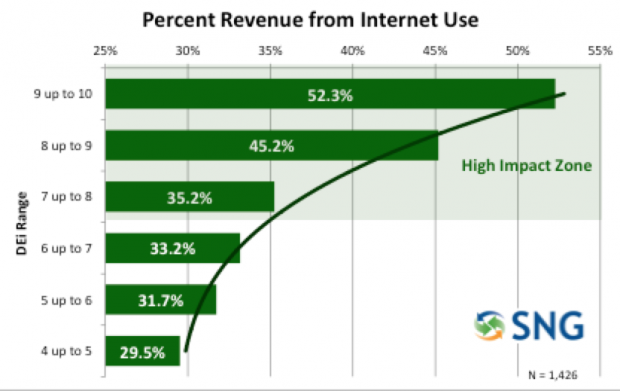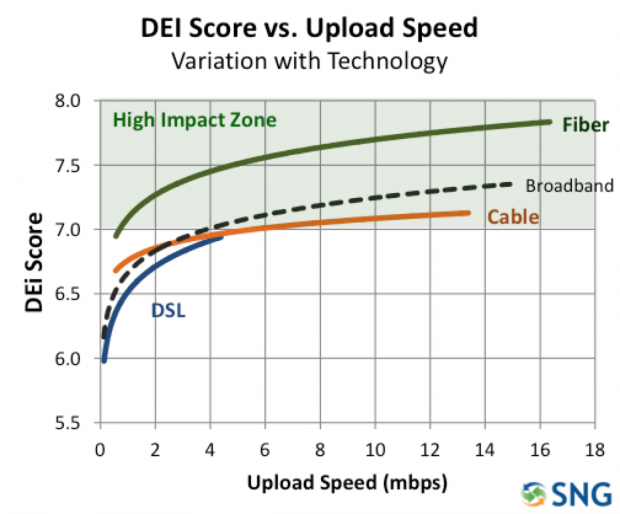
What Kind Of Speed Matters for Broadband’s Economic Development Impact?
December 16, 2015In a world moving increasingly to gigabit Internet there is no doubt that, everything else being equal, faster speeds are better, but at what point does speed make a difference? How much of a measurable economic development difference does faster deliver? For communities and regions looking to make their own business case, this detail is critical.
SNG’s research reveals that speed is indeed important, but that upload speeds (more so than download) have a greater impact on actual meaningful use and utilization amongst small and medium enterprises (SMEs). These businesses that make up 90% of all businesses have the most to gain from broadband utilization. With that, it is alarming that SNG research reveals:
- The economic benefits from broadband are severely limited unless you have at least 4 Mbps upload speeds.
- Over 70% of small businesses (fewer than 50 employees) have less than 4 Mbps upload speed [1], creating a barrier for these organizations.
 This is a major inhibitor to economic growth through broadband as SNG’s research shows that higher utilization of the Internet for online business activities brings higher revenues. SNG measures utilization using our own Digital Economy index (DEi), a normalized, weighted index of 17 potential online activities (eSolutions) covering a wide range of typical business functions. A DEi score of 10 means that all eSolutions are used, with a score of zero meaning that none are used. The average DEi score for SMEs is 6.6 (out of 10).
This is a major inhibitor to economic growth through broadband as SNG’s research shows that higher utilization of the Internet for online business activities brings higher revenues. SNG measures utilization using our own Digital Economy index (DEi), a normalized, weighted index of 17 potential online activities (eSolutions) covering a wide range of typical business functions. A DEi score of 10 means that all eSolutions are used, with a score of zero meaning that none are used. The average DEi score for SMEs is 6.6 (out of 10).
SMEs fully utilizing the Internet – a DEi score in the top range – generate 20% more of their total revenues from their online activities compared SMEs with an average DEi score. In a nutshell, the more – and more effectively – you use broadband, the more financial benefits there are to be realized by businesses. Higher utilization by SMEs increases direct revenues (and cost savings), which means greater and faster business growth, more jobs, and flow through impacts to the local economy.
Why is 4 Mbps upload speed a critical point?
 Comparing DEi scores (utilization) with upload speeds we see a high correlation with high utilization when upload speeds are above 4 Mbps. Below 4 Mpbs the utilization drops off significantly.
Comparing DEi scores (utilization) with upload speeds we see a high correlation with high utilization when upload speeds are above 4 Mbps. Below 4 Mpbs the utilization drops off significantly.
This effect is even more pronounced when broken down by the major broadband technologies in use today:
- The vast majority (71%) of fiber users have 4 Mbps of higher upload speed.
- Cable users experience a broad range of upload speeds, with only 42% above 4 Mbps.
- Over 92% of DSL SME users have less than 4 Mbps upload speed putting most DSL SMEs below the high impact zone.
Considering that about one-third of SMEs use DSL, one-third use cable, and only 8% use fiber [2], a significant portion of SMEs are constrained by lower DSL or cable speeds.
What does this mean for communities?
Speed alone will not drive utilization and impacts, but minimum upload speeds are a key enabler, empowering SMEs to take full advantage of broadband. Obviously the trend towards more fiber will help address this speed requirement. It is also important that when offering higher speeds with any technology that the service pricing is affordable compared to the lower speed alternatives.
A lot of resources have gone into broadband mapping, but to get a true read you need to do your own market research into which businesses in your area have access to 4 Mbps upload speeds and their Internet use – this may involve asking them to actually run the sped test in a survey. Identify the gaps in sufficient upload speed and make these a priority for investment in both infrastructure and broadband training so that local businesses are using the Internet applications they need to be competitive and grow.
If you are in a rural area you know that broadband is critical to keep your businesses and citizens thriving but it also is inevitably more costly to ensure availability to 4 Mbps upload speed. In the US for example, it’s unfortunate that the Connect America Funds are only requiring 10/1 Mbps fixed broadband which neither meets SNG’s recommended 4 Mbps upload nor the FCC’s new requirements of 25 down and 3 up.
For all businesses to have the opportunity to effectively participate in an economy that is increasingly online, 4Mbps is a critical minimum level of service. Some businesses will need more, however those businesses that do not have access to 4Mbps will be at a competitive disadvantage.
Next month we will cover some considerations for where you should look for funding and what your priorities to get started.
[1] Source – Strategic Networks Group, Inc. – Data collected from businesses across seven states since 2012.
[2] The remainder of about 26% use other technologies (T1, fixed or mobile wireless, satellite, etc.).
